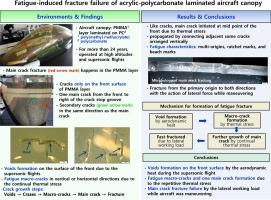Fatigue-induced fracture failure of acrylic-polycarbonate laminated aircraft canopy
IF 6.8
2区 材料科学
Q1 ENGINEERING, MECHANICAL
引用次数: 0
Abstract
The fatigue-induced fracture failure of the aircraft canopy occurred in the poly(methyl methacrylate) (PMMA) layer laminated on polycarbonate (PC) during flight. For more than 24 years, the aircraft had been operated at high altitudes and supersonic flight. To identify the root cause and the mechanism for the formation of the fracture, the fracture surfaces were investigated. The fracture morphologies were characterized using optical microscope (OM) and scanning electron microscope (SEM).
In macroscopic observations, the main crack showed a total length of approximately 1.6 m from the front to the right of the crack stop groove when viewed from the front of the canopy. The main crack ran about 0.9 m including partly curved line from the front part to the upper middle one and then reached about 0.7 m in a straight line perpendicular to the right of the crack stop groove. There were two crack ends in the main crack: one was at the lower part of the front, the other was at the right end of the crack stop groove. Numerous macro-cracks visible to the naked eye were distributed only on the front surface of the canopy.
In microscopic examination, the voids on the front surface of the outer PMMA layer were formed by the friction heat with air during the supersonic flight. The voids served as the origins, the actual starting point of the crack. The voids slowly grew to macro-cracks vertically or horizontally by the thermal stress during flying at high altitudes. Cracks proceeded in the direction of 90 degrees while being bisected in V-shapes downward from the surface of the PMMA layer with the action of thermal tension. The crack growth represents the typical characteristics of the fatigue crack: multi-origins, ratchet marks, and beach marks. The main crack grew further, forming a slight curved line by connecting adjacent macro-cracks arranged in an almost vertical direction. When crack growth reached a critical point, the catastrophic fracture progressed rapidly from the primary origin of the fatigue crack to both ends due to the action of lateral force. Fast crack zones on both sides showed the same dimple and river patterns.
This study explains that the combined and synergistic interaction of the fatigue crack and environmental stresses iteratively occurred on the front surface in the outer PMMA layer of the aircraft canopy due to the continual exposure to high altitudes and supersonic flights, consequently resulting in the fatigue-induced fracture failure.

丙烯酸-聚碳酸酯层压飞机舱盖的疲劳诱发断裂故障
飞机舱盖在飞行过程中因疲劳引起的断裂故障发生在层压在聚碳酸酯(PC)上的聚甲基丙烯酸甲酯(PMMA)层上。24 年多来,飞机一直在高空和超音速飞行。为了确定断裂的根本原因和形成机制,对断裂表面进行了研究。通过光学显微镜(OM)和扫描电子显微镜(SEM)对断裂形态进行了表征。在宏观观察中,从座舱罩前方看,主裂纹从裂纹停止槽前方到右侧的总长度约为 1.6 米。从树冠正面看,主裂缝从前部到止裂槽右侧的总长度约为 1.6 米,主裂缝从前部到中上部部分弯曲,长约 0.9 米,然后垂直于止裂槽右侧的直线长约 0.7 米。主裂缝有两个裂缝端:一个位于前端下部,另一个位于止裂槽右端。在显微镜下观察,PMMA 外层前表面的空隙是在超音速飞行过程中与空气的摩擦热形成的。这些空洞是裂纹的起源和实际起点。在高空飞行过程中,这些空隙在热应力的作用下,慢慢在垂直或水平方向上扩展成宏观裂纹。在热张力的作用下,裂纹从 PMMA 层表面向下呈 V 形一分为二,方向呈 90 度。裂纹的生长体现了疲劳裂纹的典型特征:多源、棘轮痕和沙滩痕。主裂纹进一步增长,通过连接相邻的大裂纹形成一条几乎垂直的微弯曲线。当裂纹增长达到临界点时,在侧向力的作用下,灾难性断裂从疲劳裂纹的主要起源迅速向两端发展。这项研究说明,由于持续暴露在高海拔和超音速飞行环境中,疲劳裂纹和环境应力在飞机舱盖外层 PMMA 的前表面反复发生联合协同作用,最终导致疲劳诱导断裂失效。
本文章由计算机程序翻译,如有差异,请以英文原文为准。
求助全文
约1分钟内获得全文
求助全文
来源期刊

International Journal of Fatigue
工程技术-材料科学:综合
CiteScore
10.70
自引率
21.70%
发文量
619
审稿时长
58 days
期刊介绍:
Typical subjects discussed in International Journal of Fatigue address:
Novel fatigue testing and characterization methods (new kinds of fatigue tests, critical evaluation of existing methods, in situ measurement of fatigue degradation, non-contact field measurements)
Multiaxial fatigue and complex loading effects of materials and structures, exploring state-of-the-art concepts in degradation under cyclic loading
Fatigue in the very high cycle regime, including failure mode transitions from surface to subsurface, effects of surface treatment, processing, and loading conditions
Modeling (including degradation processes and related driving forces, multiscale/multi-resolution methods, computational hierarchical and concurrent methods for coupled component and material responses, novel methods for notch root analysis, fracture mechanics, damage mechanics, crack growth kinetics, life prediction and durability, and prediction of stochastic fatigue behavior reflecting microstructure and service conditions)
Models for early stages of fatigue crack formation and growth that explicitly consider microstructure and relevant materials science aspects
Understanding the influence or manufacturing and processing route on fatigue degradation, and embedding this understanding in more predictive schemes for mitigation and design against fatigue
Prognosis and damage state awareness (including sensors, monitoring, methodology, interactive control, accelerated methods, data interpretation)
Applications of technologies associated with fatigue and their implications for structural integrity and reliability. This includes issues related to design, operation and maintenance, i.e., life cycle engineering
Smart materials and structures that can sense and mitigate fatigue degradation
Fatigue of devices and structures at small scales, including effects of process route and surfaces/interfaces.
 求助内容:
求助内容: 应助结果提醒方式:
应助结果提醒方式:


